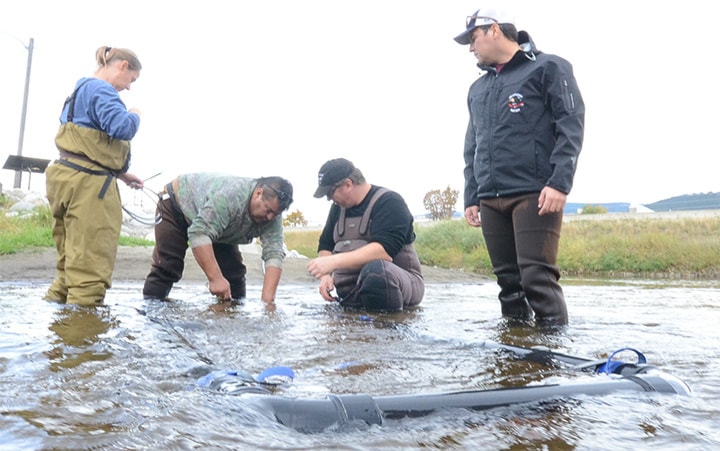High-tech and traditional monitoring methods are now in place to determine the numbers of returning Kokanee and sockeye salmon brood stock to the Okanagan River Channel.
Technicians and biologists from the Okanagan Nation Alliance fisheries division began the multimedia trial work last week, targeting the area on the north side of the Green Mountain Road bridge near the mouth of Shingle Creek.
The spawning, dark red fish are clearly visible from the bridge deck and a makeshift observation tower on the east bank which is staffed eight hours a day.
Counting methods include state-of-the-art electronic equipment, including side sonar and passive integrated (PIT) tag arrays as well as a stationary shore and water-borne human observers.
The implanted tags contain a wide range of information which when checked by a computer provide a complete history of the individual fish.
“In the whole program we’ve been studying the food web dynamic for the capacity of Skaha Lake for the number of nerkas (sockeye) with conservation concerns for resident kokanee stock (landlocked variety of the sockeye)” said biologist Skyeler Folks, one of several experts working at the site this week. “There are limitations both in, A, the capacity of the lake and, B, the spawning-ground capacity. Basically it’s a matter of figuring out who’s doing what and where and how many.”
The pilot project, is part of the bigger picture of a 12-year monitoring program as part of the reintroduction of sockeye to Skaha Lake and is in its 10th year.
“So coming near the end we need a solid way to enumerate both kokanee and sockeye within the channel as we move forward for management and conservation issues and concerns,” said Folks. “Too many and the reds (sockeye) start to superimpose over each other and you get less survival.”
He added due to a lack of the proper gradient and bottom composition, there is limited spawning sections available in the waterway.
“However things are looking good,” said Folks. “Right now we can tell there are plenty of sockeye just from the observational view from the tower.
He added big returns from each of the last three springs, as many as 10,000-14,000, plus another 5,000 to 10,000 this year, are what biologists were hoping for.
“As we move forward with enhancement and river restoration initiatives for the river channel, we need to know how many fish will be coming back and how many we can have come back, but we’re going in the right direction,” he said.
